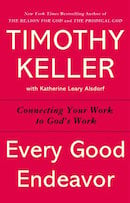Religion + Life with Elaine H. Ecklund, Part 2: Boundary Pioneers
Blog / Produced by The High Calling
One of the most intriguing ideas in Laity Leadership Senior Fellow Elaine Howard Ecklund’s book Science vs. Religion: What Scientists Really Think is the idea of “boundary pioneers.”
“A boundary pioneer is a scientist who is well respected in the scientific community and does cutting edge research, but is able to openly discuss issues related to faith in their work. By doing so, they are able to break down what is sometimes thought of as a very concrete boundary between science and faith,” Ecklund told The High Calling.
In the book, she mentions Francis Collins, director of the National Institutes of Health, as an example. He isn’t so much a pioneer because he successfully integrates his faith and his work, she wrote, but because he is willing to “talk openly about such reconciliation.”
Although both religious and non-religious scientists told Ecklund how much they dislike evangelicals (because of evangelical opposition to things like evolution and human embryonic stem cell research), not a single scientist said anything negative about Collins, who is an evangelical. His highly respected scientific identity “ushers in acceptance of his religious identity,” she wrote. It also probably helps that Collins is a theistic evolutionist, supports hESC research, and didn’t speak publicly about his faith until his career was “in the stratosphere.”
Non-religious scientists can also be boundary pioneers though. For example, Ecklund interviewed a chemist who points religious students to scientists like Collins as role models of successful faith/work integration.
Because of her own work dispelling myths regarding the Science/Religion divide, The High Calling asked Ecklund if she considers herself a boundary pioneer.
“I think to some extent, just by virtue of going into scientists’ offices and laboratories and asking them what they think about issues related to religion, spirituality, and faith more broadly, it forces them to start thinking about these things when perhaps many of them have not,” said Ecklund. “Even the nature of doing the project, of interviewing people, of having them talk for sometimes a couple of hours about these issues, helps them think more broadly about issues of meaning, both in their personal lives and in their work.”
That sounds like a yes to us.
Ecklund’s boundary pioneers are reminiscent of the pragmatic or circumspect elites described by Laity Leadership Institute Senior Fellow D. Michael Lindsay in his work. These elites prefer “incremental witness” in the workplace to “conversion campaigns” and/or see their work environments as more amenable to religion than other believers do. I would argue then that a “boundary pioneer” could be a leader in a non-scientific vocation like business, education, or law.
Can you envision yourself as a boundary pioneer?
***
Religion + Life with Elaine H. Ecklund, Part 1
Religion + Life with Elaine H. Ecklund, Part 2: Boundary Pioneers
Religion + Life with Elaine H. Ecklund, Part 3: Myth Busting
Religion + Life with Elaine H. Ecklund, Part 4: Worshiping Science
Religion + Life with Elaine H. Ecklund, Part 5: International Attitudes
Religion + Life with Elaine H. Ecklund, Part 6: Putting It All Together
Elaine Howard Ecklund is associate professor of sociology and director of graduate studies at Rice University in Houston, Texas. She studies cultural change in the areas of religion, immigration, and science. She is also a scholar at the Baker Institute for Public Policy and director of the Religion and Public Life Program at the Social Sciences Research Institute. Ecklund is author of two books: Science vs. Religion: What Scientists Really Think and Korean American Evangelicals: New Models for Civic Life.
Image by alternakive. Used with permission. Sourced via Flickr. Post by Christine A. Scheller.





